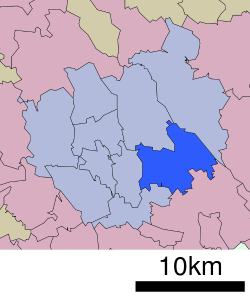- Midori-ku, Saitama
-
Midori-ku
緑区— Ward — Location of Midori-ku in Saitama Country Japan Region Kantō Prefecture Saitama Area - Total 26.51 km2 (10.2 sq mi) Population (2008) - Total 108,397 - Density 4,088.9/km2 (10,590.2/sq mi) Time zone Japan Standard Time (UTC+9) Midori-ku (緑区 Midori-ku) is one of the ten wards of Saitama located in Saitama Prefecture, Japan.
Contents
Geography
Midori-ku is located at the south-eastern corner and covers an area part of former Misono Village and an eastern section of former Urawa City. A wide area of green farmland, Minuma Rice Paddies, forms the central part of the ward. The major river system includes the Shiba River, the Ayanose River, and the Minuma Irrigational Canal. In the southern section of the ward runs the Tōhoku Expressway.
History
- The first people who stayed permanently in this area is considered to have arrived approximately twenty five thousand years ago.
- Paleolithic archaeological sites found in the area include Matsuki (松木), Wadakita (和田北), Kitajukunishi (北宿西), Mamiya Miyaushiro (間宮宮後), and the like. In the subsequent periods up to Ancient history, many sites have been found in the Ōmiya Plateau.
- In the Early modern period, the area witnessed large-scale civil engineering projects: the construction of the Minuma Reservoir (見沼溜井 Minuma Tamei), the demolition of the reservoir, and the creation of the Minuma Irrigational Canal (見沼代用水 Minumadai Yōsui). Daimon (大門) became one of the post stations or shukuba of Nikkō Onari Kaidō (日光御成街道) and known as Daimon-juku (大門宿).[1]
- In 1889 (Meiji 22), a policy change in the governmental administrative system set up five villages Tanida (谷田), Omagi (尾間木), Mimuro (三室), and Daimon (大門). Subsequently, each of them in turn merges into former Urawa City.
- In 2001, Former Urawa City, Yono City, and Ōmiya City merged and created Saitama City.
- In 2003, Midori-ku was established as a ward when Saitama City was designated by government ordinance.[2]
Controversy over name
During the merging process that established Saitama City, the proposed name Minuma (見沼), which has traditionally been referring to the region, met public opposition, for it conveys images of backwardness. In particular, the second Kanji character Swamp (沼 Numa) attracted negative reactions from residents. In a referendum, "Urawahigashi-ku" and "Higashiurawa-ku" were voted to be in first and third place, respectively. Nevertheless, they were eliminated on the ground that they contained a name of former Urawa City. The second place "Misono-ku" was also rejected because the major area of the new ward was not part of former Misono Village. "Higashi-ku", meaning "East Ward", ranked fourth in the vote was also eliminated, since Iwatsuki City, located east of Saitama City was expressing a desire to join the new city. As a result, the fifth tier choice "Midori-ku," meaning "Green Ward," became the name of the ward. [3]
Stations
- JR Higashi-Urawa Station
- Saitama Rapid Railway Line Urawa Misono Station
References
External links
 Media related to Midori-ku, Saitama at Wikimedia Commons
Media related to Midori-ku, Saitama at Wikimedia Commons Saitama Prefecture
Saitama PrefectureSaitama (capital city) 
Cities Ageo | Asaka | Chichibu | Fujimi | Fujimino | Fukaya | Gyōda | Hannō | Hanyū | Hasuda | Hidaka | Higashi-Matsuyama | Honjō | Iruma | Kasukabe | Kawagoe | Kawaguchi | Kazo | Kitamoto | Koshigaya | Kōnosu | Kuki | Kumagaya | Misato | Niiza | Okegawa | Saitama (capital) | Sakado | Satte | Sayama | Shiki | Sōka | Toda | Tokorozawa | Tsurugashima | Wakō | Warabi | Yashio | YoshikawaDistricts Former districts See also: Towns and villages by district This article incorporates material from (Midori-ku (Saitama City)) in the Japanese Wikipedia, retrieved on September 4, 2008.
Coordinates: 35°52′16″N 139°41′2″E / 35.87111°N 139.68389°E
Categories:- Saitama geography stubs
- Wards of Saitama
Wikimedia Foundation. 2010.

